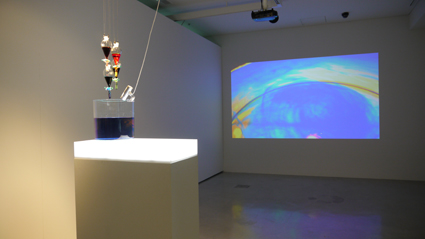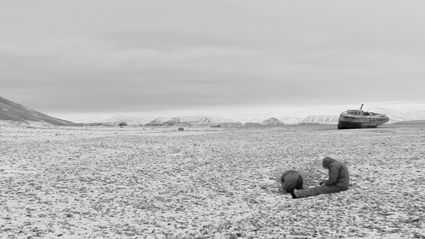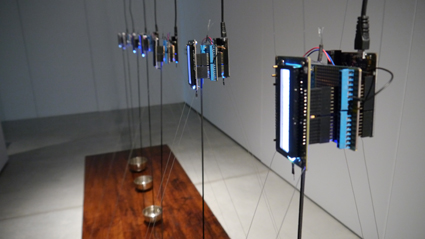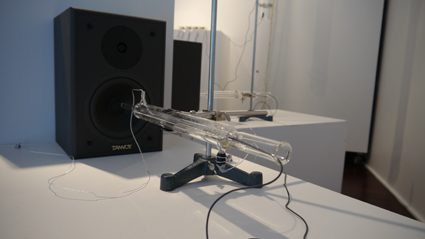Aural ecologies, mechanical and musical
Urszula Dawkins, EchoSonics, UTS Gallery

Jon Drummond, Flowforms
photo Gail Priest
Jon Drummond, Flowforms
Echo- or eco? The title EchoSonics is, depending on your accent, homonymic – and it’s the ‘eco-’ aspects of these works that unifies them: in the words of curator Nigel Helyer, the exhibition is an investigation of “acoustic ecologies”. From Ed Osborn’s study of ice-bound Svalbard to Mark Brown’s determinedly obscure Detritical Re-Vibration/Techtonic Transfer; via Minoru Sato’s ‘high-voltage hot and cold’ and two self-performing works by Jon Drummond, EchoSonics elegantly charts forays into representation, abstraction, reification and translation respectively.
Ecology is ostensibly the study of environments, but its real focus is the interrelationships that exist within them. And in EchoSonics, it’s never just sound, but always the relationship of sound to objects, physical phenomena, and our other senses, that provides traction for the conceptual underpinnings of the works.
Ed Osborn – Albedo Prospect

Ed Osborn, Albedo Prospect (video still)
courtesy the artist
Ed Osborn, Albedo Prospect (video still)
Sound and video form the foundational relationship in Albedo Prospect. A tryptich of large video screens shows slowly moving ice, still landscapes and long, smooth pans that reveal only scree and snow. The sounds are diegetic – trickling water, the faint rustle of clothing or wind. Huge-scale glaciers are resolved in perfect tonal detail, their bulk contrasting with the tiny remnants of ice and the subtle, sloshing, melting sounds of their decay. It’s meditative, distant – yet feels very ‘live’, setting up a relationship of familiar and strange.
As Osborn notes, the Arctic remains a place of essential ‘otherness’, although it has now been documented and explored extensively. He references the now-lost radio transmissions of Arthur Koestler from a 1931 airship flight over the Arctic; and has elsewhere described Albedo Prospect as a re-imagining of these missing reports. The work is the most directly ‘representational’ of EchoSonics, but its focus is poetic rather than literal, addressing loss, being-lost-ness, and perhaps the loss of our ability to be lost. It suggests our continuing otherness in relationship to what, in theory, is thoroughly mapped and knowable.
Jon Drummond – Twittering Machine and Flowforms

Jon Drummond, Twittering Machine
photo Gail Priest
Jon Drummond, Twittering Machine
Two works by Jon Drummond explore markedly different phenomena to produce aurally captivating and sensually rich sound-worlds. Flowforms synaesthetically links colour and sound, as the diffusion of bright dyes within a body of viscous liquid generates a sonic translation through headphones; a close-up shot of the slow-swirling, inanimate process adds a psychedelic component. Twittering Machine takes the global cacophony of Twitter – an abstracted, constant flow of random ‘tweets’ – and translates them electronically to an apparatus of singing-bowls struck gently by quivering wands. The subtle, melodic result feels deeply intentional and random at once, suggesting the endless chatter of cyberspace subsumed by quiet imaginings.
Mark Brown – Detritical Re-Vibration/Techtonic Transfer

Mark Brown, Detritical Re-Vibration/Techtonic Transfer
photo Gail Priest
Mark Brown, Detritical Re-Vibration/Techtonic Transfer
Described by Helyer as the ‘wild card’ of EchoSonics (see video interview), Detritical Re-Vibration/Techtonic Transfer is a work of abstracted origins that triggers a feeling of cool mystery. Constructed of industrial artefact, solenoid and servomotor, a sporadically spinning clapper glances against a small bell, just enough to polish a streak across its surface; accompanied by an insect-like, mechatronic whirr. On a screen above, glimpses of fragments of…something…fleetingly appear, visually echoing a small tray of copper-green detritus mounted alongside the spinning arm. In his interview for ISEA-in-RealTime, Nigel Helyer explains these subliminal video frames – they are 1/250th of a second snapshots of a speaker vibrating along with paint peelings and other fragments. The ‘ecology’ exposed here is that of our usually-privileged visual world, upturned to deliver a sound-world that, while somewhat arcane, is nevertheless continuous.
Minoru Sato – Thermal Acoustics

Minoru Sato, Thermal Acoustics
photo Gail Priest
Minoru Sato, Thermal Acoustics
In Thermal Acoustics, Minoru Sato beautifully aestheticises and concretises the phenomenon of heat in visible and aural form. A complex apparatus of multi-chambered glassware, wiring, mics and speakers, including four large, identical hanging tubes, initially eludes comprehension, humming softly across high and low frequencies while a mysterious brass ball is dragged mechanically around a metal plate to generate dry sparking sounds. Luckily, the artist appears just at the right moment and explains to me what’s happening: miniature heating elements inside some of the tubes change their resonating frequencies slightly, so that feedback loops created in each of the four large tubes and four small ones generate beat frequencies or standing waves. What are essentially the result of sonic differences combine to create an aural environment of soft harmony. As Sato, trained as a physicist, explains, such phenomena exist everywhere, all the time; in Thermal Acoustics, heat becomes a listening experience.






